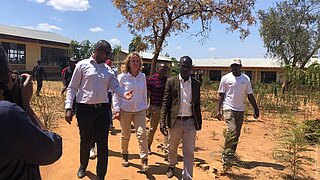Healthy ecosystems for sustainable development

Minister Steffi Lemke from the German Federal Ministry of Environment visits the IKI project "Forest and Landscape Restoration” in Rwanda.
The German Federal Minister for the Environment Steffi Lemke visited the International Climate Initiative (IKI) funded project “Forest and Landscape Restoration in Africa” (AREECA). This took place at the margins of her participation at the first Africa Protected Areas Congress (APAC) in Rwanda.
The project aims to improve the resilience of local populations against the negative impacts of climate change, reduce pressure on and loss of biodiversity-rich habitats, reduce greenhouse gas emissions, and support partner countries in achieving their development objectives relating to the Sustainable Development Goals.
The project is taking a holistic approach that reconciles ecological and socio-economic development goals. This was also emphasised by Minister Lemke’s visit: it was clear that healthy ecosystems had to go hand in hand with sustainable local economic and social development.
The restoration of forest landscapes as a topic in the classroom
On the first day of the visit to the project, the Minister was welcomed by the mayor of the Kirehe district. The Minister was accompanied by the German Ambassador and representatives from the Rwandan Ministry of Environment, the Forestry Department, IUCN (International Union for Conservation of Nature) and GIZ.
The delegation visited the Bukora Secondary School in Nyamugari sector. Both native and non-native tree species were planted in the school courtyard as part of the AREECA programme. The trees provide shade, mitigate soil erosion and provide fodder for the school's own cows in a sustainable process. The aim is on student participation: to encourage young people to be commited and interested in restoring the forest landscape.
The delegation also visited the reforestation area "Land of stones" in the Nyarubuye sector. 120 hectares of damaged land are being restored here as part of the AREECA programme. Prior to these measures, the area was severely damaged due to overgrazing and poor farming practices. The district consulted farmers to devise a joint plan of farming activities and to demonstrate their importance. Reforestation of the area with native acacia species increases the vegetation cover, provides shade for livestock and reduces land degradation.
The minister also went by the Akagera National Park to learn more about Rwanda's efforts to protect and manage important ecosystems. The Akagera Park Authority successfully involves the local communities in conservation activities to ensure the sustainability of the park and its positive effects on the surrounding communities. This is achieved by creating employment in sustainable fishing, beekeeping and agriculture.
Reforestation has social-ecological and economic benefits
On the second day, the delegation travelled to the Gatsibo district to visit implementation sites for the now completed IKI project “Piloting of multiple-benefit investment packages through forest and landscape restoration” (IPR).
At the reception for the Federal Minister, Richard Gasana, the mayor of the Gatsibo district, emphasised that the IPR project has launched several other restoration initiatives in the country and the region.
In the Gatsibo district, the delegation visited the Gabiro project site, a reforestation measure in which 186 hectares of forest were created as a buffer zone to protect the natural forest. During the project implementation in 2016, the stakeholders were keen to ensure that the measures resulted in both socio-ecological and economic benefits. The project therefore also includes a management plan that enables local farmers to practise sustainable farming, which means they can harvest fodder while protecting the maesopsis (umbrella tree) and eucalyptus trees they planted.
The last site visited by the Minister in the Rugarama sector provided an opportunity to talk directly to the farmers who were establishing agroforestry systems under the programme.
The project visit to the Rwandan districts of Kirehe and Gatsibo was an impressive demonstration of the relevance and positive impact of restoration initiatives that are embedded in the local community. The restoration of tree-rich landscapes not only strengthens the resilience of today's communities, but also makes a crucial contribution to securing a future that is fit to live in for generations to come.
The link has been copied to the clipboard
Contact
IKI Office
Zukunft – Umwelt – Gesellschaft (ZUG) gGmbH
Stresemannstraße 69-71
10963 Berlin




